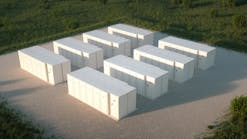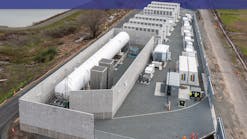How Battery Storage Will Accelerate an EV Future
Investing in a Growing EV Market
Commercial EVs, including electric buses, transit vans, and a variety of government and corporate fleets, are expected to have an annual growth rate (CAGR) of more than 10% for at least the next six years. Ford, for example, has orders for more than 10,000 transit vans from more than 300 businesses. And the numbers for an individual business can be even higher: Amazon alone plans to electrify 70,000 semi-trucks and vans. There are many more examples. Fleets of this magnitude not only require these vehicle investments; they will also require transportation depot and power grid investments.
The good news is that government support is materializing across the world. The U.S. Infrastructure Investment and Jobs Act, for example, includes around $70 billion for grid enhancements, including the incorporation of renewable energy, the development of battery storage technology, and the deployment of EV charging stations. Such investments are an essential part of ongoing sustainability mandates and net-zero targets. The transportation sector, after all, currently accounts for 27% of global carbon emissions.
Meeting Increased Energy Demands with BESS
For the transition to EVs to be truly successful, the renewable energy sector must meet increased demand for electricity. Even before accounting for the impact of the Inflation Reduction Act, energy provider National Grid predicted a 60% increase in renewable generation and 30% increase in peak demand by 2050. To support the build out of wind and solar, serious grid modernization upgrades are required in terms of high-voltage and other forms of transmission lines, smart grid systems and automated energy management, to harmonize renewable supply with changing demand and battery energy storage systems (BESS).
BESS has emerged as a key aspect of the transition toward electrification and carbon neutrality. It has a major role to play, too, in supporting the rapid ramp up of EVs. Storage will assist grid operators in maximizing the use of clean electricity and minimizing curtailment. With millions of cars, trucks, buses, and vans plugging in, demand will soar. And, demand may soar in new areas of the grid; capacity constrained distribution networks will likely benefit from BESS, which can serve as a non-wires alternative to meet this explosive growth. For the consumer sector, this surge is likely to be off-peak. When people return home from work, they will plug their vehicles in, causing spikes in usage right after the evening peak period. But demand patterns are likely to be far more variable in the commercial sector with vehicles recharging at all times of the day and night.
Adding Renewable Resources
Wind power, which tends to be supplied primarily at night and early morning, can directly meet a good portion of off-peak needs. Excess electricity from wind farms can be harnessed to charge up battery energy storage systems. Solar power will benefit from this technology too. Excess solar power can be fed to battery installations during the day for later use by depot and home charging stations. And, with the added incentives for BESS from the Inflation Reduction Act, adding more renewables to the grid in the US is easier and more cost-effective than ever.
Thus, the combination of far greater quantities of wind and solar power along with the build out of BESS will help to ensure that reliable, stable power is available whenever needed, no matter when or where. Further, BESS mitigates the Achilles heel of renewables – variability.
EV Industry Success
Innovations in charging technology coupled with the intelligent integration of distributed energy resources (DERs) and BESS have already successfully streamlined the adoption of EVs in parts of Europe. Such projects were materially assisted by grid-to-vehicle digital technologies for the control and optimization of the vehicle charging process. These systems ensure tight coordination with grid support services for peak demand limiting and the provision of ancillary services.
Pioneering fast-charging EV operator Clever, for instance, rose to the challenge when Denmark set a target of adding at least 775,000 EVs or hybrid vehicles by 2030. The company is developing a ground-breaking EV station that combines renewable energy with an advanced industrial-scale battery energy storage system coupled with digital energy management and optimization. Such projects serve as a model for other EV infrastructure efforts around the world and can assist utilities in their sustainability efforts.
Looking Ahead
Powering an electric fleet will place new demands on the grid – both during peak and off-peak hours. But as electrification initiatives accelerate, a sustainable future is achievable if sufficient investment materializes. Transmission upgrades, charging stations, and digital grid management solutions are vitally needed to support the renewable onslaught. This portfolio of essential technology solutions must include energy storage. BESS can counterbalance peaks in demand and provide distributed energy resources to support the growing demand for EV charging. When flanked by digital automation and optimization systems, a vast EV charging network can emerge that can comfortably serve the variable demands of renewable generation and the needs of a stable grid.
John Glassmire is the senior advisor of grid edge solutions at Hitachi Energy.


